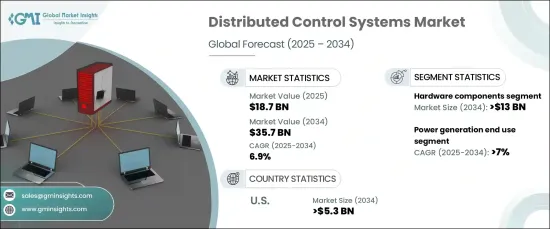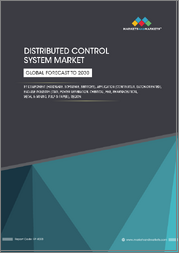
|
시장보고서
상품코드
1667126
분산 제어 시스템 시장 : 기회, 성장 촉진요인, 산업 동향 분석(2025-2034년)Distributed Control Systems (DCS) Market Opportunity, Growth Drivers, Industry Trend Analysis, and Forecast 2025 - 2034 |
||||||
세계의 분산 제어 시스템(DCS) 시장은 2024년에 187억 달러로 평가되었으며, 2025년부터 2034년에 걸쳐 CAGR 6.9%로 성장할 것으로 예측됩니다.
이러한 시장 확대는 다양한 부문에서 산업 자동화의 채택이 증가함에 따라 주도되고 있습니다. 산업계에서는 운영 효율성을 높이고, 안전을 개선하며, 사람의 개입을 줄일 수 있는 첨단 솔루션을 점점 더 많이 찾고 있습니다. 인공지능(AI), 머신러닝, 사물인터넷(IoT)과 같은 인더스트리 4.0 기술에 힘입어 스마트 제조로의 전환이 가속화되면서 이러한 시스템에 대한 수요도 증가하고 있습니다. 업계가 데이터 기반 인사이트를 통해 운영을 최적화하는 데 집중함에 따라 이러한 목표를 달성하는 데 DCS 기술은 필수 불가결한 요소가 되고 있습니다.

또한, 에너지 효율적인 솔루션에 대한 강력한 수요와 함께 재생 에너지원에 대한 관심이 높아지면서 이 모든 것이 시장을 형성하고 있습니다. 조직이 보다 지속 가능한 관행으로 전환함에 따라 기존 인프라의 현대화가 핵심 우선 순위로 떠오르면서 고급 DCS 솔루션에 대한 필요성이 더욱 커지고 있습니다. 복잡한 프로세스를 실시간으로 원격으로 제어하고 관리하는 능력에 대한 중요성이 점점 더 강조되고 있는 것도 또 다른 원동력입니다. DCS 기술을 통해 업계는 프로세스 제어를 개선하고 생산성을 향상시키며 진화하는 규정을 준수할 수 있습니다. 운영 효율성에 대한 요구가 계속 증가함에 따라 DCS 시스템은 산업 환경의 필수적인 부분이 되고 있습니다.
| 시장 범위 | |
|---|---|
| 시작 연도 | 2024년 |
| 예측 연도 | 2025-2034년 |
| 시작 금액 | 187억 달러 |
| 예측 금액 | 357억 달러 |
| CAGR | 6.9% |
구성 요소 측면에서 하드웨어 부문은 2034년까지 130억 달러의 가치를 창출할 것으로 예상됩니다. 특히 자동화가 더욱 널리 보급됨에 따라 시스템을 업그레이드하려는 업계에서는 높은 신뢰성, 확장성 및 모듈성에 대한 요구가 매우 중요합니다. 컨트롤러 및 입출력 시스템과 같은 구성 요소는 이러한 추세를 뒷받침하기 위해 높은 수요가 있습니다. 소프트웨어 측면에서는 업계에서 의사 결정 프로세스를 최적화하기 위해 노력함에 따라 고급 프로세스 제어, 실시간 분석 및 AI 통합을 위한 솔루션이 점점 더 인기를 얻고 있습니다. 또한, 다양한 운영 수준에서 원활한 연결을 보장하는 데 중요한 역할을 하는 IoT 통합과 함께 게이트웨이 및 스위치와 같은 네트워크 구성 요소에 대한 수요도 증가하고 있습니다.
공급업체들은 독립형 하드웨어 및 소프트웨어 솔루션과 함께 시스템 통합을 간소화하기 위해 두 요소를 결합한 번들 솔루션을 제공하고 있습니다. 이러한 번들 패키지는 복잡성을 줄이고 상호 운용성을 향상시키며 다양한 부문에서 DCS 시스템 배포를 간소화하도록 특별히 설계되었습니다. 이러한 추세는 업계에서 새로운 기술을 기존 인프라에 통합하기 위해 비용 효율적인 솔루션을 찾고 있기 때문에 특히 중요합니다.
발전 부문은 2034년까지 7%의 연평균 성장률을 보일 것으로 예상되는 DCS 시장에서 상당한 성장세를 보일 것으로 전망됩니다. 이러한 성장은 그리드 관리의 자동화 수요 증가와 재생 에너지원의 전력 시스템 통합에 기인한 바가 큽니다. 석유 및 가스, 제약, 식음료와 같은 주요 산업에서도 운영 효율성과 제품 품질 향상을 위해 DCS 도입을 추진하고 있습니다. 또한 인더스트리 4.0과 스마트 팩토리의 지속적인 부상으로 다양한 산업 애플리케이션에서 DCS 구현이 가속화되면서 시장 성장이 더욱 촉진되고 있습니다.
미국에서는 2034년까지 분산 제어 시스템에 대한 수요가 53억 달러에 달할 것으로 예상됩니다. 이러한 수요는 발전, 화학, 석유 및 가스 등 주요 산업 전반에서 첨단 자동화에 대한 지속적인 필요성에 의해 뒷받침되고 있습니다. IoT, AI, 클라우드 기술을 활용하는 인더스트리 4.0 이니셔티브의 부상은 계속해서 주요 성장 동력이 되고 있습니다. 또한 원활하고 안정적인 운영을 보장하기 위한 사이버 보안 및 라이프사이클 서비스에 대한 강조도 전국적으로 DCS 솔루션 도입을 촉진하고 있습니다.
목차
제1장 조사 방법과 조사 범위
- 시장의 정의
- 기본 추정과 계산
- 예측 계산
- 데이터 소스
- 1차 데이터
- 2차 데이터
- 유상
- 공적
제2장 주요 요약
제3장 업계 인사이트
- 생태계 분석
- 규제 상황
- 업계에 미치는 영향요인
- 성장 촉진요인
- 업계의 잠재적 위험 및 과제
- 성장 가능성 분석
- Porter's Five Forces 분석
- 공급기업의 협상력
- 구매자의 협상력
- 신규 참가업체의 위협
- 대체품의 위협
- PESTEL 분석
제4장 경쟁 구도
- 전략 대시보드
- 혁신과 지속가능성의 전망
제5장 시장 규모와 예측 : 구성 요소별(2021-2034년)
- 주요 동향
- 하드웨어
- 소프트웨어
- 서비스
제6장 시장 규모와 예측 : 최종 용도별(2021-2034년)
- 주요 동향
- 발전
- 석유 및 가스
- 화학
- 광업 및 금속
- 음식
- 기타
제7장 시장 규모와 예측 : 지역별(2021-2034년)
- 주요 동향
- 북미
- 미국
- 캐나다
- 멕시코
- 유럽
- 독일
- 영국
- 프랑스
- 이탈리아
- 아시아태평양
- 중국
- 일본
- 인도
- 호주
- 중동 및 아프리카
- UAE
- 사우디아라비아
- 남아프리카
- 라틴아메리카
- 브라질
- 아르헨티나
제8장 기업 프로파일
- ABB
- Azbil Corporation
- Concept Systems
- Emerson Electric
- Hitachi
- HollySys Group
- Honeywell International
- Ingeteam
- Mitsubishi Electric
- NovaTech
- Rockwell Automation
- Schneider Electric
- Siemens
- Toshiba Infrastructure Systems &Solutions
- Valmet
- Yaskawa Electric
- Yokogawa Europe
- ZAT
The Global Distributed Control Systems Market reached USD 18.7 billion in 2024 and is expected to exhibit a CAGR of 6.9% from 2025 to 2034. This market expansion is being driven by the increasing adoption of industrial automation across various sectors. Industries are increasingly seeking advanced solutions that can enhance operational efficiency, improve safety, and reduce human intervention. The shift toward smart manufacturing, boosted by Industry 4.0 technologies like artificial intelligence (AI), machine learning, and the Internet of Things (IoT), is propelling the demand for these systems. As industries focus on optimizing operations through data-driven insights, DCS technology is becoming indispensable in achieving these goals.

Additionally, there's a strong demand for energy-efficient solutions, along with a heightened focus on renewable energy sources, all of which are shaping the market. As organizations transition to more sustainable practices, the modernization of existing infrastructure is a key priority, further boosting the need for advanced DCS solutions. The growing emphasis on the ability to control and manage complex processes in real-time and remotely is another driving factor. DCS technology allows industries to improve process control, enhance productivity, and ensure compliance with evolving regulations. As the demand for operational excellence continues to rise, DCS systems are becoming an essential part of the industrial landscape.
| Market Scope | |
|---|---|
| Start Year | 2024 |
| Forecast Year | 2025-2034 |
| Start Value | $18.7 Billion |
| Forecast Value | $35.7 Billion |
| CAGR | 6.9% |
In terms of components, the hardware segment is anticipated to generate USD 13 billion by 2034. The need for high reliability, scalability, and modularity is crucial for industries looking to upgrade their systems, especially as automation becomes more widespread. Components such as controllers and input/output systems are in high demand to support this trend. On the software side, solutions for advanced process control, real-time analytics, and AI integration are growing increasingly popular as industries work to optimize decision-making processes. Moreover, the demand for network components like gateways and switches is also on the rise, with IoT integration playing a significant role in ensuring seamless connectivity across different operational levels.
Alongside standalone hardware and software solutions, vendors are now offering bundled solutions that combine both elements to simplify system integration. These bundled packages are specifically designed to reduce complexity, enhance interoperability, and streamline the deployment of DCS systems across various sectors. This trend is especially important as industries seek cost-effective solutions to integrate new technologies into their existing infrastructure.
The power generation sector is poised for significant growth within the DCS market, with a projected CAGR of 7% through 2034. This growth is largely attributed to the increasing demand for automation in grid management, as well as the integration of renewable energy sources into power systems. Key industries such as oil and gas, pharmaceuticals, and food and beverage are also driving DCS adoption, seeking to enhance operational efficiency and product quality. Furthermore, the ongoing rise of Industry 4.0 and smart factories is accelerating the implementation of DCS across various industrial applications, further propelling market growth.
In the U.S., the demand for distributed control systems is set to generate USD 5.3 billion by 2034. This demand is supported by the ongoing need for advanced automation across crucial industries such as power generation, chemicals, and oil and gas. The rise of Industry 4.0 initiatives, which leverage IoT, AI, and cloud technologies, continues to be a major growth driver. Additionally, the emphasis on cybersecurity and lifecycle services to ensure smooth and reliable operations is also fueling the adoption of DCS solutions across the country.
Table of Contents
Chapter 1 Methodology & Scope
- 1.1 Market definitions
- 1.2 Base estimates & calculations
- 1.3 Forecast calculation
- 1.4 Data sources
- 1.4.1 Primary
- 1.4.2 Secondary
- 1.4.2.1 Paid
- 1.4.2.2 Public
Chapter 2 Executive Summary
- 2.1 Industry synopsis, 2021 - 2034
Chapter 3 Industry Insights
- 3.1 Industry ecosystem analysis
- 3.2 Regulatory landscape
- 3.3 Industry impact forces
- 3.3.1 Growth drivers
- 3.3.2 Industry pitfalls & challenges
- 3.4 Growth potential analysis
- 3.5 Porter's analysis
- 3.5.1 Bargaining power of suppliers
- 3.5.2 Bargaining power of buyers
- 3.5.3 Threat of new entrants
- 3.5.4 Threat of substitutes
- 3.6 PESTEL analysis
Chapter 4 Competitive Landscape, 2024
- 4.1 Strategic dashboard
- 4.2 Innovation & sustainability landscape
Chapter 5 Market Size and Forecast, By Component, 2021 – 2034 (USD Million)
- 5.1 Key trends
- 5.2 Hardware
- 5.3 Software
- 5.4 Services
Chapter 6 Market Size and Forecast, By End Use, 2021 – 2034 (USD Million)
- 6.1 Key trends
- 6.2 Power generation
- 6.3 Oil & gas
- 6.4 Chemicals
- 6.5 Mining & metals
- 6.6 Food & beverage
- 6.7 Others
Chapter 7 Market Size and Forecast, By Region, 2021 – 2034 (USD Million)
- 7.1 Key trends
- 7.2 North America
- 7.2.1 U.S.
- 7.2.2 Canada
- 7.2.3 Mexico
- 7.3 Europe
- 7.3.1 Germany
- 7.3.2 UK
- 7.3.3 France
- 7.3.4 Italy
- 7.4 Asia Pacific
- 7.4.1 China
- 7.4.2 Japan
- 7.4.3 India
- 7.4.4 Australia
- 7.5 Middle East & Africa
- 7.5.1 UAE
- 7.5.2 Saudi Arabia
- 7.5.3 South Africa
- 7.6 Latin America
- 7.6.1 Brazil
- 7.6.2 Argentina
Chapter 8 Company Profiles
- 8.1 ABB
- 8.2 Azbil Corporation
- 8.3 Concept Systems
- 8.4 Emerson Electric
- 8.5 Hitachi
- 8.6 HollySys Group
- 8.7 Honeywell International
- 8.8 Ingeteam
- 8.9 Mitsubishi Electric
- 8.10 NovaTech
- 8.11 Rockwell Automation
- 8.12 Schneider Electric
- 8.13 Siemens
- 8.14 Toshiba Infrastructure Systems & Solutions
- 8.15 Valmet
- 8.16 Yaskawa Electric
- 8.17 Yokogawa Europe
- 8.18 ZAT



















